Typhoon Durian
Typhoon Durian, known in the Philippines as Typhoon Reming, was a deadly tropical cyclone that wreaked havoc in the Philippines and later crossed the Malay Peninsula in late November 2006, causing massive loss of life when mudflows from the Mayon Volcano buried many villages.
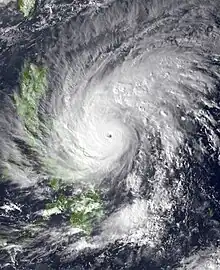 Durian approaching the Philippines at peak intensity on November 29 | |
| Meteorological history | |
|---|---|
| Formed | November 25, 2006 |
| Remnant low | December 6, 2006 |
| Dissipated | December 6, 2006 (December 9 per JTWC) |
| Violent typhoon | |
| 10-minute sustained (JMA) | |
| Highest winds | 195 km/h (120 mph) |
| Lowest pressure | 915 hPa (mbar); 27.02 inHg |
| Category 4-equivalent super typhoon | |
| 1-minute sustained (SSHWS/JTWC) | |
| Highest winds | 250 km/h (155 mph) |
| Lowest pressure | 904 hPa (mbar); 26.70 inHg |
| Overall effects | |
| Fatalities | >1,500 |
| Damage | >$580 million (2006 USD) |
| Areas affected | Yap State, Philippines, Vietnam, Thailand, Malaysia, Andaman Islands, India |
| IBTrACS | |
Part of the 2006 Pacific typhoon season | |
Durian first made landfall in the Philippines, packing strong winds and heavy rains that caused mudflows near Mayon Volcano. After causing massive damage in the Philippines, it exited into the South China Sea and weakened slightly, before managing to reorganise and restrengthen into a typhoon shortly before its second landfall, this time in Vietnam near Ho Chi Minh City, causing further damage of more than US$450 million. In all, Durian killed almost 2,000 people,[1][2] and left hundreds more missing. Damages in the Philippines from the typhoon amounted to 5.086 billion PHP (US$130 million).[3]
Meteorological history
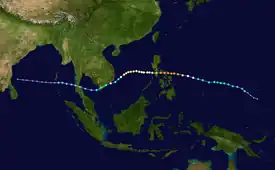
Tropical storm (39–73 mph, 63–118 km/h)
Category 1 (74–95 mph, 119–153 km/h)
Category 2 (96–110 mph, 154–177 km/h)
Category 3 (111–129 mph, 178–208 km/h)
Category 4 (130–156 mph, 209–251 km/h)
Category 5 (≥157 mph, ≥252 km/h)
Unknown
Typhoon Durian formed as a tropical depression on November 24, 2006 near Chuuk State. Situated south of a ridge, the system tracked west-northwest through a region of low wind shear and good upper-level divergence.[4] Late on November 26, the depression intensified into a tropical storm and was named Durian by the Japan Meteorological Agency (JMA)[nb 1] Steady strengthening took place over the following two days as the system approached the Philippines. After attaining typhoon status on November 29,[5] Durian underwent a period of rapid intensification,[4] culminating with it attaining peak 10 minute maximum sustained winds of 195 km/h (121 mph) and a central barometric pressure of 915 mbar (hPa; 27.02 inHg). Durian brushed the southern coast of the Catanduanes at this intensity on November 30, where a record gust of 320 km/h (200 mph) was observed.[5][6]
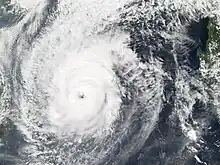
Slight weakening took place before the storm made landfall in the Bicol Region.[5] Land interaction precipitated further degradation of storm, though it retained typhoon status upon emerging over the South China Sea on December 1,[4] having passed just 80 km (50 mi) south of Metro Manila.[7] Some re-intensification occurred, with Durian reaching a secondary peak on December 3. Subsequently, increasingly hostile conditions caused the system to weaken to a severe tropical storm as it turned southwest. The storm had initial intensifies before struck southern Vietnam early on December 5 as a minimal typhoon before diminishing to a tropical depression.[5] The system turned westward once again and crossed the Malay Peninsula.[8] The JMA ceased tracking the storm on December 6 when it crossed west of 100° E and into the North Indian Ocean basin,[5] although the Joint Typhoon Warning Center (JTWC)[nb 2] continued tracking it through the Bay of Bengal. Failing to reorganize, Durian degenerated into a remnant low on December 6, before ultimately dissipating three days later off the coast of Andhra Pradesh, India, on December 9.[8]
Preparations
Philippines
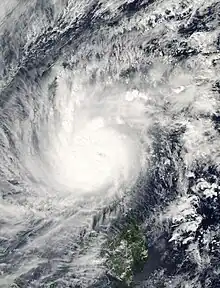
The Bicol region, where Durian first struck, is located at the southeastern portion of the Philippine island of Luzon, and is affected by an average of 8.4 tropical cyclones per year.[10] Before Durian made its damaging landfall in the Philippines, the Philippine Atmospheric, Geophysical and Astronomical Services Administration (PAGASA) issued various tropical cyclone warnings and watches, including Public Storm Warning Signal #4 for Catanduanes, Albay, and both Camarines Sur and Norte provinces; this is the highest warning signal, in which winds of over 100 km/h (60 mph) were expected.[11][12] PAGASA turned off its weather radar in Virac to prevent damage.[11] The Philippines' National Disaster Coordinating Council issued severe weather bulletins and advisories,[13] and overall, 25 provinces in the archipelago were placed on storm alert.[14] Residents in warning areas were advised of the potential for storm surge, flash flooding, and landslides.[13]
The severe threat of the typhoon prompted over 1.3 million people to evacuate their homes, many of whom stayed in the 909 storm shelters.[13] Officials advised residents in low-lying areas to seek higher grounds.[11] School classes in Sorsogon and in Northern and Eastern Samar were suspended,[13] and many buildings opened up as storm shelters.[11] In Naga City, about 1,500 citizens left for emergency shelters. 1,000 were evacuated elsewhere in the region,[15] including 120 in the capital city of Manila and more than 800 in Legazpi City.[14] The threat of the typhoon caused ferry, bus, and airline services to be canceled,[11] stranding thousands of people for several days.[12] All shipping traffic was halted in the Mimaropa region.[16] The Philippine Coast Guard grounded all vessels on open waters, stranding around 4,000 ferry passengers in Quezon province.[14] PAGASA turned off its weather radar in Virac to prevent damage.[11]
Vietnam
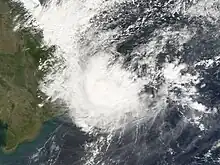
On November 30, while the typhoon was over the Philippines, the Central Committee for Flood and Storm Control and the National Committee for Search and Rescue sent telegraphs advising of the typhoon to search and rescue teams stationed along the entire coast of the country (Quảng Ninh province to Cà Mau). All provinces along the South China Sea were advised to assist an estimated 14,585 vessels in the path of the storm.[17] All craft were later banned from leaving harbors.[18] Requests were also made to neighboring countries to allow Vietnamese fishermen to take refuge in their ports.[19] Strong wind warnings were disseminated to residents between Phú Yên and Bà Rịa–Vũng Tàu provinces by December 2. These areas, as well as the inland provinces of Đắk Lắk, Lâm Đồng, and Bình Phước redirected all focus on the typhoon and the potential for life-threatening flash flooding.[20] Evacuation orders for southern provinces were issued by December 3, with Deputy Prime Minister Nguyễn Sinh Hùng stating, "the evacuation must be completed by Monday morning [December 4]."[18] Threatening an area not frequented by typhoons, many residents did not heed warnings as weather conditions ahead of the storm were calm. Approximately 6,800 people in Ninh Thuận province complied with the evacuation orders; however, officials requested the assistance of the Vietnamese Army to relocate roughly 90,000 people.[21] Following an unpredicted southerly shift in the storm's track towards the Mekong Delta, Hung later urged residents and officials to prepare for the storm, such that "all provinces should prepare so that we do not have another Linda."[22]
Impact
Yap
Early in its duration, Durian produced light winds on Yap in the Caroline Islands, gusting to 56 km/h (35 mph), as well as light rainfall totaling 52 mm (2.0 in). Ahead of the storm, the National Weather Service on Guam issued a tropical storm warning for various islands in Yap State.[23]
Philippines
| Rank | Storm | Season | Fatalities | Ref. |
|---|---|---|---|---|
| 1 | "Haiphong" | 1881 | 20,000 | [24] |
| 2 | Yolanda (Haiyan) | 2013 | 6,300 | [25] |
| 3 | Uring (Thelma) | 1991 | 5,101–8,000 | [26] |
| 4 | Pablo (Bopha) | 2012 | 1,901 | [26] |
| 5 | "Angela" | 1867 | 1,800 | [27] |
| 6 | Winnie | 2004 | 1,593 | [27] |
| 7 | "October 1897" | 1897 | 1,500 | [27][28] |
| 8 | Nitang (Ike) | 1984 | 1,426 | [29] |
| 9 | Reming (Durian) | 2006 | 1,399 | [27][26] |
| 10 | Frank (Fengshen) | 2008 | 1,371 | [nb 3][30][31] |
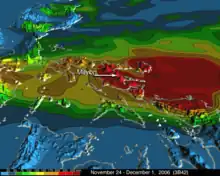
Typhoon Durian affected about 3.5 million people in the Philippines,[13] of whom about 120,000 were left homeless.[32] Durian damaged 588,037 houses, including 228,436 that were destroyed, many of which were made out of wood.[13][33] Across the country, the storm wrecked 5,685 schools, estimated at US$63.5 million in damage. The Bicol Region accounted for 79% of the damaged schools, affecting around 357,400 children.[34] Damage was estimated at ₱5.45 billion (PHP, US$110 million).[13][nb 4] As of December 27, 2006, the death toll stood at 734, with 762 missing.[13] The International Disaster Database listed 1,399 deaths in the Philippines related to Durian,[36] making it the second deadliest natural disaster in 2006 after an earthquake in Indonesia.[37]
While crossing the Philippines, Durian dropped 466 mm (18.3 in) of rainfall at Legazpi, Albay in 24 hours,[38] including an hourly total of 135 mm (5.3 in).[33] The 24 hour total was the highest in 40 years for a station in the Bicol region.[10] Heavy rainfall caused rivers and irrigation canals to exceed their banks.[33] Many creeks and small streams were flooded in the Bicol region.[10] Gusts were estimated as high as 260 km/h (160 mph).[33]
While the typhoon moved through the country, it caused complete power outages in Albay, Sorsogon, Camarines Sur, and Camarines Norte,[11] affecting tens of thousands of residents.[14] Initially, disrupted communications prevented details about the damage in the worst struck areas.[39] The worst of the storm effects were in Albay, Camarines Sur, Catanduanes, Mindoro, and Quezon.[40] On Catanduanes Island, Durian destroyed about half of the houses in the capital city of Virac.[16] The powerful winds of the typhoon blew away houses and uprooted trees,[15] All of the trees in Bacagay were knocked down, affecting the livelihood of half of the residents. Throughout the country, about 30,000 ha (74,000 acres) of rice fields were destroyed,[41] accounting for 65,481 metric tons of corn; 19,420 metric tons of rice were also damaged. However, the crops were already harvested, so the storm's agriculture effects were minor.[13] The storm also wrecked 1,200 fishing boats, severely affecting the local fishing industry, and killed many livestock.[41]
Mayon Volcano

The eye of Durian passed near Mayon Volcano as it struck the Bicol region. In the mountainous region, a process known as orographic lift produced heavier rainfall than near the coast, with totals possibly as high as 600 mm (24 in).[33] On November 30, the rainfall became very heavy and prolonged, saturating the soil.[10] Lahars – a type of landslide originating from a volcanic ash – formed quickly along the southern and eastern rims of Mayon Volcano, which had produced a fresh layer of ash in August 2006. The lahars destroyed dykes and dams meant to contain the debris flow,[33] which were not designed to prevent major landslides.[38] Warnings were issued for potential lahars, but the rapid development of the debris flows as well as power outages meant populations did not receive adequate warning. Initially, the lahars were contained by a layer of grasslands, although the unstable nature of the volcanic soil caused the grounds to collapse. Within 21 minutes, the lahars descended Mayon Volcano, quickly covering and wrecking six communities. After the initial series of lahars, further ash flow descended to the ocean to the north of Mayon Volcano.[33] Areas around the volcano were inundated with 1.5 m (5 ft) of floodwaters.[39] Widespread flooding was also reported in Legazpi City.[14]
North of Legazpi, the ash flow covered or damaged portions of the Pan-Philippine Highway.[33] In the small barangay – small town – of Maipon, nearby streams coalesced into a valley filled with muddy waters. The landslide arrived quickly and washed away or destroyed houses in the path. Several people died while attempting to cross to higher grounds. Similar conditions affected nearby Daraga, where 149 people died. Around that city, the landslide reached 2 m (6.6 ft) deep and 307 m (1,007 ft) wide, enough to cover 3 story buildings, while floods enlarged the nearby Yawa River by 600%.[10] About 13,000 families had to leave their homes due to the landslides.[42] Many roads and bridges were wrecked around the volcano, which halted transportation and impacted relief work.[43]
In Albay province alone, there were 604 deaths and 1,465 people who sustained injuries. Damage in the province totaled $71 million (USD).[44] The storm also damaged 702 of the 704 schools in the province.[45]
Vietnam
Durian brought maximum 10-mins sustained winds up to 110 km/h and gusted to 150 km/h to the southern Vietnamese coastline. Strong winds capsized several boats offshore Vietnam, killing two with one missing.[46] In Bình Thuận Province alone, 820 boats sank,[47] and throughout the country 896 fishing boats sank.[48]
Heavy rainfall from the typhoon destroyed 22 schools and 1,120 houses in Bình Thuận Province. Strong winds from Durian blew off the roofs of about 500 houses in Bà Rịa–Vũng Tàu province.[47] Throughout the nation, the passage of the typhoon destroyed 34,000 homes, with an additional 166,000 damaged. Typhoon Durian killed 85 in the country and injured 1,379 others. Total damages were 7.234 trillion VND (US$450 million).[49]
Aftermath
Philippines
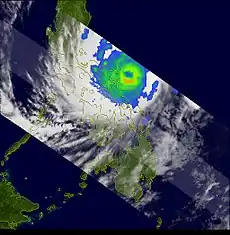
On December 3, Philippine President Gloria Macapagal Arroyo declared a state of national calamity, due to the successive impacts of typhoons Xangsane, Cimaron, and Durian.[13] Arroyo ordered the immediate release of 1 billion Philippine pesos ($20.7 million, 2006 USD) for relief in areas affected by typhoons Durian, Xangsane, and Cimaron.[50] This relief fund was increased to 3.6 billion pesos ($74.8 million, 2006 USD) on December 6, including an additional 150 million pesos ($3.1 million) for power grid repair.[51] The government used over ₱500 million (PHP) from their Countryside Development Fund.[52] Soon after Durian exited the country, workers began restoring power lines and clearing debris and trees from roads,[16] which was required before relief agencies reached the hardest hit areas.[12] As of December 1, 3,316 families had fled their homes to storm shelters.[7] Immediately after the storm's landfall, reports of deaths or injuries had not yet reached the media centres.[15] As officials made contact with the hardest hit areas, the death toll quickly rose to 190 by December 1,[12] and to 720 by two weeks later.[53]
On December 17, the Philippine government issued a $46 million appeal to the United Nations for financial assistance coping with Durian.[13] This was after the country already depleted its yearly emergency funding for disasters.[54] In response, various United Nations' departments provided about $2.6 million in emergency funding, and by late December 2006, 14 countries had provided donations to the Philippines.[13] By the end of January, only 7.1% of the appeal was raised.[34] By the end of April 2007, four Asian countries – China, Indonesia, Malaysia, and Singapore – donated ₱54 million (US$2.2 million) worth of emergency supplies, such as clothing, medicine, and food.[55][56] Various companies and local organizations donated to the relief effort, such as medicine, food, water, transport supplies, clothes, and money.[57] Individuals and corporations donated ₱68 million (US$1.4 million) in cash and supplies.[55] The international response came shortly after the calamity status was declared. On December 3, Canada released $1 million (US$860,000) for local relief through its embassy in Manila and through the International Red Cross and Red Crescent Movement.[50][58] UNICEF donated 4,000 packages containing food, mattresses, and blankets, and UNOCHA donated $1– 2 million (USD) for relief supplies.[58] Spain donated $250,000 (USD) and sent medical teams, medicines, food, and supplies to affected areas.[59] The United States donated $250,000 plus supplies through the USAID program, and the Filipino community on Saipan contributed cash, food, and supplies.[58] Australia released $1 million (US$792,000) through its AusAID program.[58] Indonesia sent two C-130 Hercules aircraft to Legazpi City, carrying a total of 25 tons of food, medicine, and clothing valued at 1.17 billion Indonesian rupiah (US$129,000).[59] Japan pledged tents, blankets, generators, and water management equipment through the Japan International Cooperation Agency.[59] Malaysia donated 20 tons of food and medicines, and Singapore sent two batches of supplies valued at $50,000 (USD) through Singapore Airlines.[58] The Republic of Korea pledged $100,000 (USD) cash, while the People's Republic of China pledged $200,000 (USD).[59] Israel donated $7,500 (USD), mostly in medicines and medical supplies.[59]
The Red Cross, which responded to the repeated storms of 2006, launched an appeal that raised $9.67 million for the Philippines. In March 2009, the agency completed the missions responding to the 2006 storms and transferred the remaining funds to help repair from Typhoon Fengshen in 2008.[60] The International Organization for Migration developed the Humanitarian Response Monitoring System in response to problems in the management of the aftermath of Durian,[61] and also provided 12,750 metric tons of building supplies, medicine, and water in the storm's immediate aftermath.[62] OXFAM built 242 latrines and 99 bath houses to ensure proper hygiene.[45] The Tzu Chi Foundation set up a temporary medical camp in Tabaco to provide free health care to storm victims.[63] The International Labour Organization built a livelihood center in February 2008 to help provide jobs to storm victims.[37] The World Bank, in conjunction with the Philippines' National Power Corporation, funded a $21.6 million project to repair the damaged power lines in the typhoons' aftermath. The agencies also upgraded 118 electrical towers by 2008 to stabilize power supply during typhoons. As a result, there were minimal power outages during the passage of Tropical Storm Higos (Pablo) in 2008.[64]
Beginning in January 2007, the United Nations Food and Agriculture Organization distributed about 150 packs of vegetable seeds and farm tools to displaced residents in three Bicol provinces, as part of the sustainable recovery program planned by the Philippine government for storm victims.[65][41] By a year after the typhoon, farmers had regrown their rice and vegetables, utilizing a rebuilt irrigation system. The World Food Programme supplied fishermen with materials to rebuild damaged boats, allowing them to resume catching fish by May 2007.[41] The agency also provided monthly food rations to displaced residents in Albay,[66] totaling 294 tons of rice to about 6,000 families;[67] however, the food distribution programs ended in December 2007, causing food shortages in the first few months of 2008 among those still displaced.[42] UNICEF distributed 1,750 water purification tablets, along with jerrycans and water containers, to ensure access to clean water.[45]

After the successive impacts of Xangsane and Durian caused widespread power outages, the Bicol region lost about $250 million in economic output.[64] The unemployment rate in the Bicol region rose to about 30%, and many who retained their jobs earned less than before the storm.[37] In the aftermath of Durian, all relief activities were coordinated through the Philippines' departments of Health and Social Welfare and Development. A fleet of over 200 vehicles transported relief supplies – food, construction materials, clothing, and medicine – to the Bicol region on December 12. The Philippine Air Force airlifted supplies and medical teams to Bicol and offshore Catanduanes, with the National Disaster Coordinating Council supplying 17,350 sacks of rice to those areas. The Departments of Social Welfare and Development and the Department of Health sent teams to help victims cope with stress and consoled the families of the deceased, aided by psychiatrists. The Department of Health also distributed tents and sleeping bags, provided vaccines to people in evacuation camps, and ensured proper burial of storm casualties. There was a minor outbreak of diarrhea in the evacuation camps that affected 142 people in Legazpi, and other evacuees were also ailed by the cold, coughing, and fever. Local governments in Albay worked to ensure areas retained clean water by using disinfectants and temporary latrines.[13] The Philippine government provided ₱119 million (US$2.4 million) toward rebuilding the damaged schools in Albay, only 23% of the required cost to repair all of the schools.[45]
The government assessed that about 35% of those who lost their houses had the resources to rebuild without assistance; this meant that 144,692 houses had to be rebuilt.[34] Many of the storm victims left homeless resided in tent camps, schools, and temporary shelters, until more permanent buildings were built.[42][45] The Red Cross housed about 60,000 people across ten provinces in temporary shelters.[68] The Philippine government planned to quickly build more permanent homes, although there were difficulties in securing land and materials for the new housing. By March 2007, government and international agencies only provided 6.9% of the necessary homes, forcing people to stay in shelters longer than expected.[45] By a year after the storm, over 10,000 families still stayed in transit camps in Albay and Camarines Sur.[62] Various organizations helped the homeless secure housing. The government of Italy funded a ₱26 million (US$525,000) project to rebuild 180 houses in Albay. The Italian government also helped build new livelihood centers to provide jobs, provided new boats, and donated about 80,000 coconut seeds to replant trees.[69] In the eight months after Durian struck, the Philippine National Red Cross, in conjunction with the International Red Cross, delivered building supplies to about 12,000 families to repair their homes or build new ones. The organizations encouraged residents to rebuild houses away from vulnerable areas.[70] The International Organization for Migration, in conjunction with the United States Agency for International Development, built 907 homes and new community centers.[71] The Philippine government released ₱76 million ($1.5 million) in funds to build 1,089 houses.[72] UNICEF provided emergency funding to rebuild 50 daycare centers that were damaged by the typhoon.[73] Habitat for Humanity helped repair about 1,200 homes,[74] build about 2,000 new houses, and rebuilt four schools in Sorsogon.[75]
Around Mayon Volcano, officials enacted search and rescue missions for victims affected by landslides.[13] Workers quickly excavated lahar-filled valleys, bridges, and river beds to rebuild dykes. Farmers quickly regrew damaged crops, while schools and homes were cleaned and rebuilt. Stronger concrete dykes were built around populated communities.[33] The government developed relocation plans for three landslide-prone areas in Albay.[13] In 2011, the Regional Development Council approved a budget to construct additional dams along the Mayon Volcano to prevent the deadly floods and landslides that occurred during Durian.[76] Dams were scheduled to be constructed around the volcano after a 1981 study, but these were delayed due to budget constraints.[10]
Vietnam
In Vietnam, which had recently been affected by Typhoon Xangsane, the national government released 150 billion Vietnamese đồng ($9 million, 2006 USD) in food and supplies to families in affected areas.[77] The United States donated $100,000 (USD), and its Oxfam organisation donated $200,000 (USD) to the most affected provinces.[77] The International Red Cross and Red Crescent Movement launched an emergency appeal for $2.47 million (USD) to support the efforts of the Vietnam Red Cross, which distributed over 2,000 packets of supplies and over 2 tonnes of rice, medicine, and clothes.[78]
Retirement
The 39th session of the United Nations Economic and Social Commission for Asia and the Pacific/World Meteorological Organization's Typhoon Committee met in Manila, Philippines from December 4–9, soon after the onslaught of the floods from Durian. The committee's regional director stated in their report, "I wish to extend WMO’s sincere condolences and sympathy to your Government and to the Philippine people who were adversely affected by the past typhoons." During the session, the committee retired the name Durian,[79] replacing it with Mangkhut in 2008;[80] which was later retired after its usage in 2018.[81] PAGASA also retired the local name "Reming" in 2006 and replaced it with "Ruby",[82] which was also later retired following its usage in 2014.[83]
See also
- Typhoons in the Philippines
- Other typhoons that impacted the Philippines in 2006:
- Typhoon Yunya (1991) - Another strong typhoon that created lahars, resulting from the 1991 eruption of Mount Pinatubo in the Philippines, leading to hundreds of indirect deaths
- Tropical Storm Thelma (1991) - Another deadly storm that led to torrential rainfall and flooding, which killed thousands in the Philippines
- Tropical Storm Linda (1997) - Also managed to cross over from the Northwest Pacific Ocean into the North Indian Ocean
- Tropical Depression Winnie (2004) - A weak storm that killed more than 1,500 people in the Philippines
- Typhoon Haiyan (2013) - Another extremely strong tropical cyclone that also devastated the Central Philippines, remains the deadliest storm in Philippine history
- Tropical depressions Wilma and BOB 05 (2013) - Also traversed the Northwest Pacific Ocean and the North Indian Ocean
- Typhoon Melor (2015) - Had an identical track though slightly weaker, caused severe damage that led to its name being retired
- Typhoon Nock-ten (2016) - Had a similar track and intensity, also had its name retired due to substantial damage
- Typhoon Kammuri (2019) - A late-season powerful typhoon that ravaged over Bicol Region, leading to the retirement of the name.
- Typhoon Goni (2020) - The strongest landfalling tropical cyclone on record, made landfall in the Philippines with 1-minute sustained winds of 315 km/h (195 mph), leading to its name retirement.
Notes
- The Japan Meteorological Agency is the official Regional Specialized Meteorological Center for the western Pacific Ocean.[5]
- The Joint Typhoon Warning Center is a joint United States Navy – United States Air Force task force that issues tropical cyclone warnings for the western Pacific Ocean and other regions.[9]
- The death and missing columns includes deaths caused by Typhoon Fengshen (Frank), in the MV Princess of the Stars disaster.
- The total was originally reported in Philippine pesos. Total converted via the Oanda Corporation website.[35]
References
- Analysis: Indonesia: Earthquake - May 2006, Disaster data: A balanced perspective - Mar 2007, Analysis: Southeast Asia: Typhoon Durian - Dec 2006, Disaster data: A balanced perspective - Mar 2007
- Situation Reports: Southeast Asia: Typhoon Durian - Dec 2006, Viet Nam: Typhoons Revised Appeal No. MDRVN001 Operation Update No. 3, Situation Reports: Southeast Asia: Typhoon Xangsane - Sep 2006, Viet Nam: Typhoons Revised Appeal No. MDRVN001 Operation
- "Costliest Typhoons Of The Philippines". Typhoon2000.ph. Retrieved 2015-12-23.
- Gary Padgett; Kevin Boyle & Simon Clarke (March 7, 2007). "Monthly Global Tropical Cyclone Summary – November 2006" (Report). Typhoon 2000. Retrieved July 20, 2013.
- Annual Report on Activities of the RSMC Tokyo: Typhoon Center 2006 (PDF) (Report). Japan Meteorological Agency. 21. Retrieved October 14, 2014.
- Dominic Alojado & David Michael V. Padua (July 29, 2010). "Strongest Typhoons of the Philippines (1947–2009)". Typhoon 2000. Retrieved July 21, 2013.
- "Philippines: Typhoon Durian (Reming) - DREF Bulletin no. MDRPH003". International Federation of Red Cross And Red Crescent Societies. ReliefWeb. December 1, 2006. Retrieved October 20, 2014.
- "Typhoon 24W 2006 (Durian) Best Track" (.TXT). Joint Typhoon Warning Center. United States Navy. 2007. Retrieved July 20, 2013.
- "Joint Typhoon Warning Center Mission Statement". Joint Typhoon Warning Center. 2011. Archived from the original on 2007-07-26. Retrieved October 14, 2014.
- Jerry A. Fano; Michael T. Alpasan; Takeo. Mitsunaga; Yoshio Tokunaga (October 2007). The Mayon 2006 Debris Flow (PDF). FCSEC Technical Report (Report). Vol. 3. Department of Public Works and Highways. pp. 2, 4. Retrieved December 26, 2015.
- "Philippines: NDCC media update - Typhoon "Reming" (Durian) 30 Nov 2006". Government of the Philippines. ReliefWeb. November 30, 2006. Retrieved October 14, 2014.
- "Philippines: Typhoon OCHA Situation Report No. 1". United Nations Office for the Coordination of Humanitarian Affairs. ReliefWeb. December 1, 2006. Retrieved October 20, 2014.
- Final Report on the Effects of Typhoon "Reming" (Durian) (PDF) (Report). National Disaster Coordinating Council. December 27, 2006. Archived from the original (PDF) on March 4, 2016.
- "Powerful Typhoon Durian blows away houses, knocks off power as it slams into Philippines". Associated Press. 2006-11-29. Retrieved 2007-02-20.
- "Powerful Typhoon Durian lashes eastern Philippines". USA Today. Associated Press. 2006-12-01. Retrieved 2007-02-20.
- "Philippines: NDCC media update Typhoon "Reming" (Durian) 01 Dec 2006". Government of the Philippines. December 1, 2006. Retrieved October 20, 2014.
- "Viet Nam: Flash report No. 367 - 1st December 2006". Government of Vietnam. ReliefWeb. December 1, 2006. Retrieved July 19, 2013.
- "Vietnam evacuates 50,000 ahead of typhoon Durian". Hanoi, Vietnam: ReliefWeb. Agence France-Presse. December 4, 2006. Retrieved July 19, 2013.
- "Typhoon Durian claims 18 lives in Vietnam". Hanoi, Vietnam: ReliefWeb. Xinhua. December 5, 2006. Retrieved July 19, 2013.
- "Viet Nam: Urgent telegraph - No.09 typhoon with strong wind force". Government of Vietnam. ReliefWeb. December 2, 2006. Retrieved July 19, 2013.
- "Vietnam evacuates 90,000 ahead of typhoon Durian". Hanoi, Vietnam: ReliefWeb. Agence France-Presse. December 4, 2006. Retrieved July 19, 2013.
- "Typhoon kills 44 in Vietnam, flooding fears". Ho Chi Minh City, Vietnam: ReliefWeb. Reuters. December 5, 2006. Retrieved July 19, 2013.
- . Tinian, Guam National Weather Service. December 4, 2006 – via Wikisource.
- Philippine Storm Surge History. Project NOAH, University of the Philippines. November 23, 2013. Archived from the original on November 8, 2014. Retrieved November 29, 2013.
- Del Rosario, Eduardo D (August 9, 2011). Final Report on Typhoon "Yolanda" (Haiyan) (PDF) (Report). Philippine National Disaster Risk Reduction and Management Council. pp. 77–148. Archived (PDF) from the original on November 5, 2020. Retrieved March 27, 2022.
- Alojado, Dominic (2015). Worst typhoons of the Philippines (1947-2014) (PDF) (Report). Weather Philippines. Retrieved September 25, 2015.
- "10 Worst Typhoons that Went Down in Philippine History". M2Comms. August 3, 2016. Retrieved August 3, 2016.
- Lotilla, Raphael (November 20, 2013). "Flashback: 1897, Leyte and a strong typhoon". Rappler. Retrieved July 10, 2014.
- "Deadliest typhoons in the Philippines". ABS-CBNNews. November 8, 2013. Archived from the original on November 13, 2013. Retrieved November 8, 2013.
- Padua, David M (June 10, 2011). "Tropical Cyclone Logs: Fengshen (Frank)". Typhoon 2000. Archived from the original on December 1, 2010. Retrieved December 31, 2011.
- Rabonza, Glenn J. (July 31, 2008). Situation Report No. 33 on the Effects of Typhoon "Frank"(Fengshen) (PDF) (Report). National Disaster Coordinating Council (National Disaster Risk Reduction and Management Center). Archived (PDF) from the original on September 27, 2013. Retrieved December 31, 2011.
- Philippines: Asia's "super-storm" gathers over South China Sea. World Vision (Report). November 23, 2007. Retrieved December 27, 2015.
- Geoffrey A. J. Scott (2010). "An overview of destruction and recovery in the Mt. Mayon volcano region, Bicol, Philippines, resulting from lahars initiated by Supertyphoon Reming" (PDF). Geographical Essays. 13. Retrieved December 23, 2015.
- "Philippines: Typhoon OCHA Situation Report No. 9". United Nations Office for the Coordination of Humanitarian Affairs. ReliefWeb. January 29, 2007. Retrieved May 3, 2017.
- "Historical Exchange Rates". Oanda Corporation. 2013. Retrieved December 26, 2015.
- Centre for Research on the Epidemiology of Disasters. "EM-DAT: The Emergency Events Database". Université catholique de Louvain.
- Getting out of the mud: How the ILO helps typhoon victims in the Philippines. International Labour Organization (Report). ReliefWeb. March 27, 2008. Retrieved December 27, 2015.
- E. M. R. Paguican; A. M. F. Lagmay; K. S. Rodolfo; R. S. Rodolfo; A. M. P. Tengonciang; M. R. Lapus; E. G. Baliatan; E. C. Obille Jr. (October 2009). "Extreme rainfall-induced lahars and dike breaching, 30 November 2006, Mayon Volcano, Philippines". Bulletin of Volcanology. 71 (8): 845–857. Bibcode:2009BVol...71..845P. doi:10.1007/s00445-009-0268-8. S2CID 140189053.
- "Philippines: Typhoon Reming appeal". Philippine National Red Cross. ReliefWeb. November 30, 2006.
- Philippines: Typhoons Appeal no. MDRPH002 Operations Update no.6. International Federation of Red Cross And Red Crescent Societies (Report). ReliefWeb. March 7, 2008. Retrieved December 27, 2015.
- "Philippines: The slow process of typhoon recovery". ReliefWeb. IRIN. March 31, 2008. Retrieved December 27, 2015.
- "Philippines: Seeking to rebuild lives swept away by mudslides". ReliefWeb. IRIN. March 25, 2008. Retrieved December 27, 2015.
- "Philippines: Aid teams head into typhoon zone". World Vision. ReliefWeb. December 1, 2006.
- Noralene Uy; Yukiko Takeuchi; Rajib Shaw (2011). "Local adaptation for livelihood resilience in Albay, Philippines". Environmental Hazards. 10 (2): 142. doi:10.1080/17477891.2011.579338.
- Philippines: Typhoons OCHA Situation Report No. 13 (PDF). United Nations Office for the Coordination of Humanitarian Affairs (Report). ReliefWeb. March 2, 2007. Retrieved December 28, 2015.
- CBC (2006-12-04). "Vietnam braces for weakened Typhoon Durian". CBC News. Retrieved 2007-02-24.
- "Typhoon Durian tears into southern Vietnam, killing 26". Reuters. 2006-12-05. Retrieved 2007-02-24.
- United Nations Office for the Coordination of Humanitarian Affairs (2006). "Viet Nam: Typhoon Durian OCHA Situation Report No. 1". Retrieved 2007-02-24.
- 2006 VIETNAM Report
- "Contributions: Southeast Asia: Typhoon Durian - Dec 2006, Philippines: PGMA declares state of national calamity in aftermath of typhoon 'Reming'". ReliefWeb.
- Manila Bulletin Online
- "Philippines: Gov't tap CDF savings for rehabilitation of areas damaged by "Reming"". Government of the Philippines. ReliefWeb. December 1, 2006. Retrieved October 16, 2014.
- Situation Reports: Southeast Asia: Typhoon Durian - Dec 2006, Philippines: NDCC media update - Typhoon "Reming" (Durian) 13 Dec 2006
- Philippines: 2006 typhoon appeal. Swedish International Development Cooperation Agency (Report). ReliefWeb. February 12, 2007. Retrieved December 29, 2015.
- Philippines: Donations thru the DSWD for victims of typhoon "Reming" as of 30 April 2007. Government of the Philippines (Report). ReliefWeb. April 30, 2007. Retrieved December 28, 2015.
- Philippines: DSWD kicks-off Japan-funded food-for-work project for typhoon Reming victims. Government of Japan (Report). ReliefWeb. July 20, 2007. Retrieved December 28, 2015.
- "Philippines: DSWD list of donors and donations for victims of TY Reming". Government of the Philippines. ReliefWeb. January 29, 2007. Retrieved May 3, 2017.
- Situation Reports: Southeast Asia: Typhoon Durian - Dec 2006, Philippines: Typhoon OCHA Situation Report No. 4
- Situation Reports: Southeast Asia: Typhoon Durian - Dec 2006, Philippines: NDCC media update - Typhoon "Reming" (Durian) 06 Dec 2006, 6pm
- Philippines: Typhoons Appeal no. MDRPH002 Firnal report. International Federation of Red Cross And Red Crescent Societies (Report). ReliefWeb. March 6, 2009. Retrieved December 27, 2015.
- IOM Hands Over Disaster Response Tracking Database to Philippines Government. International Organization for Migration (Report). ReliefWeb. January 15, 2010. Retrieved December 27, 2015.
- Philippines: Typhoon survivors celebrate Christmas one year on. International Organization for Migration (Report). December 21, 2007. Retrieved December 27, 2015.
- Tzu Chi's medical mission to Philippines: Protecting the health of the poor. Buddhist Tzu Chi Foundation (Report). ReliefWeb. March 9, 2007. Retrieved December 28, 2015.
- Philippines: Bicol Power Restoration Project (PDF) (Report). World Bank. April 17, 2012. Retrieved December 23, 2015.
- Philippines: FAO donates vegetable seeds, farm tools to new settlements. International Organization for Migration (Report). ReliefWeb. August 5, 2008. Retrieved December 27, 2015.
- Philippines president visits WFP typhoon relief operation. World Food Programme (Report). ReliefWeb. August 29, 2007. Retrieved December 27, 2015.
- WFP expands aid to victims of typhoon Reming in the Philippines. World Food Programme (Report). ReliefWeb. February 23, 2007. Retrieved December 28, 2015.
- Philippines: Typhoons Appeal no. MDRPH002 Operations Update no.5. International Federation of Red Cross And Red Crescent Societies (Report). ReliefWeb. July 20, 2007. Retrieved December 28, 2015.
- Philippines: Italian gov't-assisted projects in Albay amount to P26 million. Government of the Philippines (Report). ReliefWeb. November 11, 2008. Retrieved December 27, 2015.
- Erik Olsson (June 26, 2009). Red Cross builders brace for Philippine storms. International Federation of Red Cross And Red Crescent Societies (Report). ReliefWeb. Retrieved December 27, 2015.
- Philippines - US Ambassador hands over IOM-USAID homes to displaced survivors of Typhoon Reming. International Organization for Migration (Report). ReliefWeb. October 24, 2008. Retrieved December 27, 2015.
- Philippines: DSWD releases P76m for construction of core shelter units in Bicol. Government of the Philippines (Report). ReliefWeb. July 6, 2007. Retrieved December 28, 2015.
- EE Jerusalem (August 12, 2008). Philippines: UNICEF assists construction/rehab of day-care centers in Bicol. Government of the Philippines (Report). ReliefWeb. Retrieved December 27, 2015.
- Philippines: Blitz build to boost HFH Philippines' new home constructions In typhoon-hit Bicol. Habitat for Humanity International (Report). September 3, 2007. Retrieved December 27, 2015.
- HFH Philippines to rebuild four schools and 3,000 homes for Typhoon Durian survivors. Habitat for Humanity International (Report). ReliefWeb. February 6, 2007. Retrieved January 18, 2016.
- Ed de Leon (March 2, 2011). Philippines: Dams to be built around Mt. Mayon. Government of the Philippines (Report). ReliefWeb. Retrieved December 23, 2015.
- Situation Reports: Southeast Asia: Typhoon Durian - Dec 2006, Viet Nam: Typhoon Durian OCHA Situation Report No. 2
- Press Releases: Southeast Asia: Typhoon Durian - Dec 2006, Vietnam: Emergency funds sought following Durian
- ESCAP/WMO Typhoon Committee Thirtyninth Session (PDF) (Report). World Meteorological Organization. 2006. Retrieved December 23, 2015.
- "List of Retired Typhoon Names". ESCAP/WMO Typhoon Committee. 2015. Retrieved December 23, 2015.
- "Typhoon Committee adopt new typhoon name". China Meteorological Agency. 2007. Archived from the original on December 8, 2007. Retrieved 2007-12-11.
- Helen Flores (May 11, 2011). "'Bebeng' out of Pagasa name list". Philippine Star. Retrieved December 26, 2015.
- "Philippine Tropical Cyclone Names". Philippine Atmospheric, Geophysical and Astronomical Services Administration. Archived from the original on February 1, 2015. Retrieved February 1, 2015.
External links
- JMA General Information of Typhoon Durian (0621) from Digital Typhoon
- JMA Best Track Data of Typhoon Durian (0621) (in Japanese)
- JTWC Best Track Data of Super Typhoon 24W (Durian)
- 24W.DURIAN from the U.S. Naval Research Laboratory
- ReliefWeb's main page for this event.

